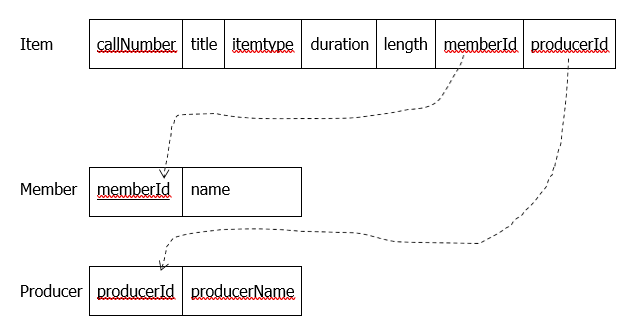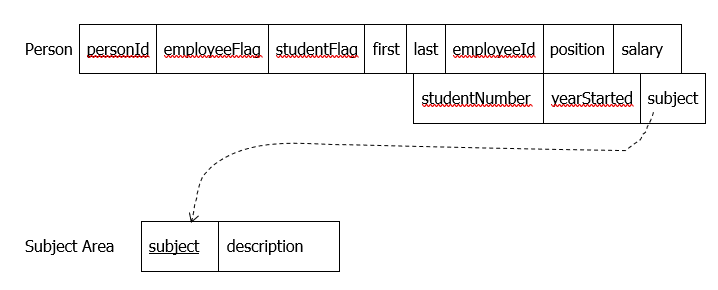APPENDIX B
B.4.3: One Relation Representing the Whole Hierarchy
When this option is applied one relation is created for a complete hierarchy. All attributes appearing in the hierarchy are placed in one relation. Note that the value of a discriminator attribute will enable the user to know easily the subtype of a particular entity. For our example models, when we map a hierarchy to a single relation we obtain very simple relational designs.
It is left as an exercise for the student to create databases with sample data.
Example:
The library model maps to the following design:

In the Item relation the itemType attribute indicates if the row represents a video, a magazine, or a book. The memberId may have a value if the item is out on loan. producerId can only have a value if itemType is “video”.
Example:
When mapping a hierarchy to a single relation for the university model the designer should include discriminator attributes that are boolean-valued with one discriminator attribute per subtype. Applying this option to the university model we have:

With this database each person is stored at most once in the database; there is no duplicated data as with the previous mapping option.
If a person is neither an employee nor a student then the only attributes that can have values are: personId, employeeFlag, studentFlag, first and last – the others must be null. The values of employeeFlag and studentFlag would be false.
Exercises
Exercises
1) Consider the database designs illustrated in this appendix. Implement one or more of these and populate with data.
2) Consider the two designs used in the examples of this appendix. Combine these two designs by replacing Member with the Person hierarchy. Illustrate the relational structures when the model is mapped to a database. Choose mapping options for the hierarchies.
3) Consider the design you created in exercise 2 but modify the one-to-many borrows relationship to be a many-to-many with attributes dateBorrowed and dateReturned where dateBorrowed is a discriminator for the relationship. Recall this discriminator is not the same as the discriminators suggested for mapping supertypes and subtypes.
- Note that this modification to the library example will allow history to be recorded for the borrowing of items.
4) For exercise 3 create the database and populate the database with sample data.
5) Create an ERD for a service station business that provides goods and services to its customers. Typically, a customer comes in with their vehicle and requests certain work to be performed. For example, a customer may request an oil change and for a new set of four tires to be provided and installed.
- The work items that can be performed or supplied can be of two types: a service (such as the oil change) and actual physical items (such as litres of oil). There will be several services that can be performed such as tire installation, changing oil, or fixing a flat tire.
- Each of these will have some cost to be charged to a customer. There are many concrete items that are supplied and charged to a customer such as fan belts, litres of oil, or tires – these are things that are kept in inventory. Consider creating a hierarchy for products (goods / services); make up reasonable attributes.
- This service station has customers that fall into two groups: some are private individuals and others are businesses. Individuals will have a first name, last name, address and phone number. A business will have a business name, address, phone number and a contact person who has a first name and last name. Consider creating a hierarchy for customers.
- The service station needs to keep track of all the goods and services it provides to its customers so that it has a historical record and knows what it has charged to each customer. Each visit to the service station by a customer will generate a work order that keeps track of the work that was done for the customer’s vehicle. Vehicles have license plate numbers, and other attributes to describe them (make, model, colour, …). For each visit of a customer to the station the system needs to know the date the visit occurred, the details of the work performed and goods provided, and the total charge to the customer.

